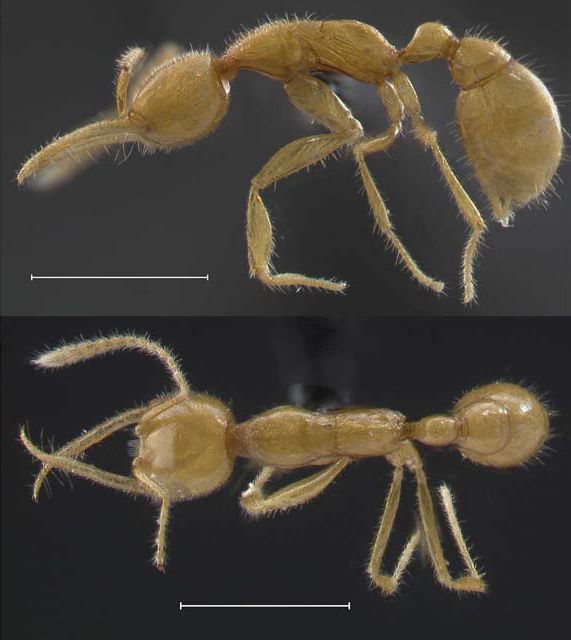 AUSTIN, Texas—A new species of blind, subterranean, predatory ant discovered in the Amazon rainforest by University of Texas at Austin evolutionary biologist Christian Rabeling is likely a descendant of the very first ants to evolve.
AUSTIN, Texas—A new species of blind, subterranean, predatory ant discovered in the Amazon rainforest by University of Texas at Austin evolutionary biologist Christian Rabeling is likely a descendant of the very first ants to evolve.
The new ant is named Martialis heureka, which translates roughly to “ant from Mars,” because the ant has a combination of characteristics never before recorded. It is adapted for dwelling in the soil, is two to three millimeters long, pale, and has no eyes and large mandibles, which Rabeling and colleagues suspect it uses to capture prey.
The ant also belongs to its own new subfamily, one of 21 subfamilies in ants. This is the first time that a new subfamily of ants with living species has been discovered since 1923 (other new subfamilies have been discovered from fossil ants).
Rabeling says his discovery will help biologists better understand the biodiversity and evolution of ants, which are abundant and ecologically important insects.
“This discovery hints at a wealth of species, possibly of great evolutionary importance, still hidden in the soils of the remaining rainforests,” writes Rabeling and his co-authors in a paper reporting their discovery this week in theProceedings of the National Academy of Sciences.
Rabeling collected the only known specimen of the new ant species in 2003 from leaf-litter at the Empresa Brasileira de Pesquisa Agropecuária in Manaus, Brazil.
He and his colleagues found that the ant was a new species, genus and subfamily after morphological and genetic analysis. Analysis of DNA from the ant’s legs confirmed its phylogenetic position at the very base of the ant evolutionary tree.
Ants evolved over 120 million years ago from wasp ancestors. They probably evolved quickly into many different lineages, with ants specializing to lives in the soil, leaf-litter or trees, or becoming generalists.
“This discovery lends support to the idea that blind subterranean predator ants arose at the dawn of ant evolution,” says Rabeling, a graduate student in the ecology, evolution and behavior program.
Rabeling does not suggest that the ancestor to all ants was blind and subterranean, but that these adaptations arose early and have persisted over the years.
“Based on our data and the fossil record, we assume that the ancestor of this ant was somewhat wasp-like, perhaps similar to the Cretaceous amber fossil Sphecomyrma, which is widely known as the evolutionary missing link between wasps and ants,” says Rabeling.
He speculates that the new ant species evolved adaptations over time to its subterranean habitat (for example, loss of eyes and pale body color), while retaining some of its ancestor’s physical characteristics.
“The new ant species is hidden in environmentally stable tropical soils with potentially less competition from other ants and in a relatively stable microclimate,” he says. “It could represent a ‘relict’ species that retained some ancestral morphological characteristics.”
Rabeling’s co-authors include Jeremy Brown, also a graduate student at The University of Texas at Austin, and Dr. Manfred Verhaagh of Staatliches Museum für Naturkunde in Karlsruhe, Germany. Brazilian ecologist Dr. Marcos Garcia assisted with the research in the Amazon.

















Comments 1
what are the benefits of green tea in weight loss, I discovered your blog site on google and check a few of your early posts. Proceed to maintain up the very good operate. I just extra up your RSS feed to my MSN News Reader. Seeking ahead to reading more from you later on!…